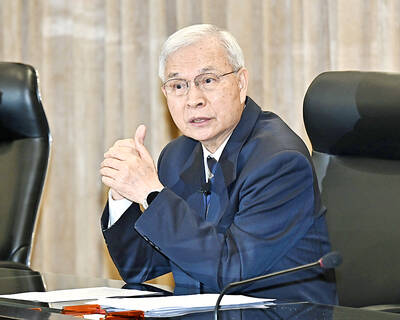Scientists on Wednesday offered more evidence that COVID-19 is spread by seemingly healthy people who show no clear symptoms and the US government issued new guidance warning that anyone exposed to the disease can be considered a carrier.
A study by researchers in Singapore became the latest to estimate that about 10 percent of new infections might be sparked by people who carry the virus, but have not experienced its flu-like symptoms.
In response to that study and others, the US Centers for Disease Control and Prevention changed how it defined the risk of infection.
The agency’s new guidance targeted people who have no symptoms, but were exposed to others with known or suspected infections. It essentially says that anyone might be a carrier, regardless of any symptoms.
The findings increase the challenges of containment measures, the researchers wrote, but added that the magnitude of the effects depends on the extent and duration of transmissibility while a patient is pre-symptomatic, which has so far not been clearly established.
The findings complicate efforts to gain control of the pandemic and reinforce the importance of “social distancing” and other measures designed to stop the spread, experts said.
“You have to really be proactive about reducing contacts between people who seem perfectly healthy,” said Lauren Ancel Meyers, a researcher at the University of Texas at Austin who has studied coronavirus transmission in different countries.
The newest research was published online on Wednesday by the CDC in its Morbidity and Mortality Weekly Report.
It focused on 243 cases of coronavirus reported in Singapore from mid-January through the middle of last month, including 157 infections among people who had not traveled recently.
Scientists found that so-called pre-symptomatic people triggered infections in seven disease clusters, accounting for about 6 percent of the locally acquired cases.
One of those infections was particularly striking. A 52-year-old woman’s infection was linked to her sitting in a seat at a church that had been occupied earlier in the day by two tourists who showed no symptoms, but later fell ill, investigators said after they reviewed closed-circuit camera recordings of church services.
An earlier study that focused on China, where the virus was first identified, suggested that more than 10 percent of transmissions were from people who were infected, but did not yet feel sick.
The seemingly healthy people who can transmit the virus are believed to fall into three categories: pre-symptomatic, who do not have symptoms when they spread, but develop the illness a couple of days later; asymptomatic, who never develop symptoms; and post-symptomatic, who get sick and recover, but remain contagious.
The Singapore and China studies focused on pre-symptomatic infections.
It remains unclear how many new infections are caused by each type of potential spreader, said Meyers, who was not involved in the Singapore study, but was part of the earlier one focused on China.
In the initial months of the pandemic, health officials based their response on the belief that most of the spread came from people who were sneezing or coughing droplets that contained the virus.
Additional reporting by Reuters

The CIA has a message for Chinese government officials worried about their place in Chinese President Xi Jinping’s (習近平) government: Come work with us. The agency released two Mandarin-language videos on social media on Thursday inviting disgruntled officials to contact the CIA. The recruitment videos posted on YouTube and X racked up more than 5 million views combined in their first day. The outreach comes as CIA Director John Ratcliffe has vowed to boost the agency’s use of intelligence from human sources and its focus on China, which has recently targeted US officials with its own espionage operations. The videos are “aimed at

STEADFAST FRIEND: The bills encourage increased Taiwan-US engagement and address China’s distortion of UN Resolution 2758 to isolate Taiwan internationally The Presidential Office yesterday thanked the US House of Representatives for unanimously passing two Taiwan-related bills highlighting its solid support for Taiwan’s democracy and global participation, and for deepening bilateral relations. One of the bills, the Taiwan Assurance Implementation Act, requires the US Department of State to periodically review its guidelines for engagement with Taiwan, and report to the US Congress on the guidelines and plans to lift self-imposed limitations on US-Taiwan engagement. The other bill is the Taiwan International Solidarity Act, which clarifies that UN Resolution 2758 does not address the issue of the representation of Taiwan or its people in

US Indo-Pacific Commander Admiral Samuel Paparo on Friday expressed concern over the rate at which China is diversifying its military exercises, the Financial Times (FT) reported on Saturday. “The rates of change on the depth and breadth of their exercises is the one non-linear effect that I’ve seen in the last year that wakes me up at night or keeps me up at night,” Paparo was quoted by FT as saying while attending the annual Sedona Forum at the McCain Institute in Arizona. Paparo also expressed concern over the speed with which China was expanding its military. While the US

SHIFT: Taiwan’s better-than-expected first-quarter GDP and signs of weakness in the US have driven global capital back to emerging markets, the central bank head said The central bank yesterday blamed market speculation for the steep rise in the local currency, and urged exporters and financial institutions to stay calm and stop panic sell-offs to avoid hurting their own profitability. The nation’s top monetary policymaker said that it would step in, if necessary, to maintain order and stability in the foreign exchange market. The remarks came as the NT dollar yesterday closed up NT$0.919 to NT$30.145 against the US dollar in Taipei trading, after rising as high as NT$29.59 in intraday trading. The local currency has surged 5.85 percent against the greenback over the past two sessions, central